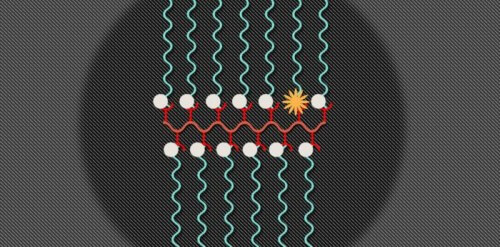Chemists have succeeded in developing innovative nanoparticles that can perform, simultaneously, two types of imaging - magnetic resonance and fluorescence, in the laboratory. Particles of this kind could help scientists follow the path of specific molecules formed in the body, monitor the environment of a cancerous tumor and even determine if the drugs taken successfully reached their desired destination

[Translation by Dr. Nachmani Moshe]
Chemists have succeeded in developing innovative nanoparticles that can perform, simultaneously, two types of imaging - magnetic resonance and fluorescence, in the laboratory. Particles of this kind could help scientists follow the path of specific molecules formed in the body, monitor the environment of a cancerous tumor and even determine if the drugs taken successfully reached their desired destination.
Chemists from the Massachusetts Institute of Technology (MIT) succeeded in developing innovative nanoparticles that could perform, simultaneously, two types of imaging - magnetic resonance and fluorescence, in real life. Particles of this kind could help scientists follow the path of specific molecules formed in the body, monitor the environment of a cancerous tumor and even determine if the drugs taken successfully reached their desired destination. In an article published in the scientific journal Nature Communications, the researchers demonstrated the use of the new particles, which include distinct magnetic resonance and fluorescence detectors, to track vitamin C in mice. When the concentration of the vitamin is high, the particles show a strong fluorescence signal with weak magnetic resonance imaging (MRI) contrast. If the vitamin concentration is low, a stronger magnetic resonance signal is obtained and the fluorescence signal becomes weak.
Future versions of the particles could be used for the detection of reactive oxygen species often linked to the development of various diseases, says Jeremiah Johnson, professor of chemistry at MIT and lead author of the paper. It will also be possible to design the particles so that they can detect more than a single molecule at a time. "Much more can be learned about the development of diseases if image detectors are used that enable the sensing of specific biomolecules," adds the lead researcher.
The researchers designed their particles in such a way that they can be constructed from building blocks consisting of polymer chains attached to an organic contrast agent (nitroxide) used in magnetic resonance imaging or to a fluorescent molecule (Cy5.5).
When these two components are mixed in desired ratios, the building blocks join together to form a defined nanostructure that the researchers call a 'branched bottlebrush polymer'. For this study they synthesized particles consisting of 99% nitroxide-bearing chains and only 1% of the fluorescent molecule.
Nitroxides are very active molecules that contain a nitrogen atom bonded to an oxygen atom that has a single electron. These molecules suppress the fluorescence of the second component (Cy5.5), but when the nitroxide comes into contact with a molecule from which it can receive an additional electron, such as vitamin C, it becomes inactive and the second component begins to glow with fluorescence. Nitroxides usually have a very short life time in living systems, however one of the scientists involved in the research recently discovered that their life time can be extended by attaching two large chemical groups to them. Moreover, the authors showed that the incorporation of nitroxide within the polymer structure leads to even greater improvements in terms of the lifetime of the nitroxide. Following these changes, nitroxides can remain in the bloodstream for several hours - long enough to make useful MRI measurements possible.
The researchers found that their imaging particles accumulated in the liver, as is usually the case for nanoparticles. The liver of the mouse produces vitamin C, so as soon as the particles reach the liver, they receive electrons from the vitamin there, turning off the MRI signal and increasing the fluorescence. The researchers also did not find any MRI signal in the brain, but they did find a low level of fluorescence there, an organ that is the target for much of the vitamin C produced in the liver. In contrast, in the circulation and kidneys, where vitamin C concentration is low, the MRI signal was at its maximum level.
The researchers are currently working on increasing the difference between the two types of signals when the detector encounters a target molecule such as vitamin C. The researchers were also able to produce nanoparticles capable of carrying the radioactive material together with up to three different drugs. This allows the researchers to examine whether the nanoparticles actually reach their necessary targets. "This is the great advantage of our system - we can mix, match and add almost any material we want," says the lead researcher.
These particles could also be used to estimate the concentration rate of oxygen radicals in cancerous tumors, a finding that could provide essential information regarding the severity of the cancer. "We believe that it is possible to reveal information about the cancer environment with the help of these detectors, if we can get them there," claims the lead researcher. "One day we will be able to inject these nanoparticles into a patient and receive biochemical information in real time regarding disease sites and track healthy tissues within, a mechanism that is not so simple today."
